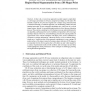Free Online Productivity Tools
i2Speak
i2Symbol
i2OCR
iTex2Img
iWeb2Print
iWeb2Shot
i2Type
iPdf2Split
iPdf2Merge
i2Bopomofo
i2Arabic
i2Style
i2Image
i2PDF
iLatex2Rtf
Sci2ools
ECCV
2008
Springer
2008
Springer
Robust 3D Pose Estimation and Efficient 2D Region-Based Segmentation from a 3D Shape Prior
In this work, we present an approach to jointly segment a rigid object in a 2D image and estimate its 3D pose, using the knowledge of a 3D model. We naturally couple the two processes together into a unique energy functional that is minimized through a variational approach. Our methodology differs from the standard monocular 3D pose estimation algorithms since it does not rely on local image features. Instead, we use global image statistics to drive the pose estimation process. This confers a satisfying level of robustness to noise and initialization for our algorithm, and bypasses the need to establish correspondences between image and object features. Moreover, our methodology possesses the typical qualities of region-based active contour techniques with shape priors, such as robustness to occlusions or missing information, without the need to evolve an infinite dimensional curve. Another novelty of the proposed contribution is to use a unique 3D model surface of the object, instead ...
2D-3D Pose Estimation | Computer Vision | ECCV 2008 | Monocular 3D Pose | Pose Estimation | Pose Estimation Process | Work 2D Image |
| Added | 15 Oct 2009 |
| Updated | 15 Oct 2009 |
| Type | Conference |
| Year | 2008 |
| Where | ECCV |
| Authors | Samuel Dambreville, Romeil Sandhu, Anthony J. Yezzi, Allen Tannenbaum |
Comments (0)

